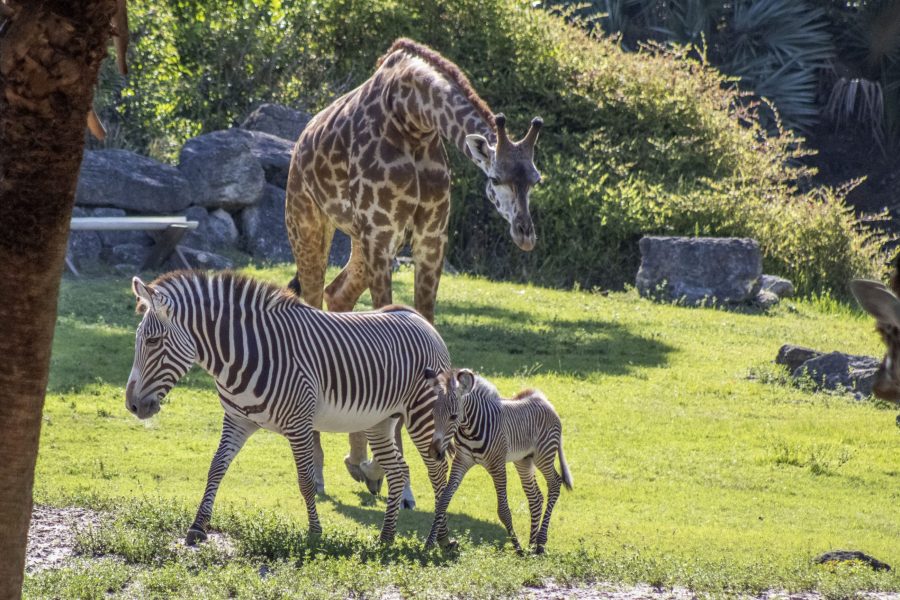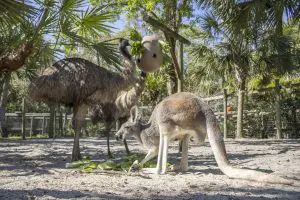

It’s a giraffe…it’s an impala…it’s the Africa veldt! Wander around our Zoo, and you’ll find some habitats are home to a variety of animals. These multi- or mixed-species spaces provide a unique experience for our animals and guests alike. Interested in learning what goes into creating these spaces? Read on to find out from our animal care team!
Caring for Different Needs
As you might imagine, it can be hard to give appropriate care to a variety of animals in one habitat. Each has their own set of food, social, enrichment and space needs.
Our animal care team is always closely monitoring our residents daily as well as completing yearly assessments to look at every component of that animal’s life to make sure all their needs are being met, said Christen Carrillo, area supervisor of Wild Florida.
This includes special training to ensure all animal residents are getting the appropriate resources. Under the direction of our veterinary team, our animal residents are given specific diet items and quantities to ensure they’re at their healthiest. We don’t want their habitat-mates to nab all of it!
Our Herps & Aquatics team target trains all the fish in our Rainforest Revealed aquarium during feeding time to ensure they’re getting their food – if not, bottom feeders like our tiger shovelnose catfish would never get their food! If it was just tossed in, the red-bellied pacu would eat it.
“As keepers we must be able identify each species and be able to cater to individual needs,” said Jenna Bakhuizen, area supervisor of Herps & Aquatics. “They are always a challenge to enrich because they all have different natural behaviors that we are trying to encourage.”
 Enrichment also needs to be safe for all residents in a multi-species habitat. These items or experiences aim to encourage our animals to act on their natural instincts like foraging, exploring, etc. What might be safe for one animal – like cardboard for our red kangaroos – might be dangerous for other curious residents – like our Galapagos tortoises who also live in Kangaroo Walkabout. Sometimes you need to get extra creative with enrichment, said Lands of Change area supervisor Mic McPherson.
Enrichment also needs to be safe for all residents in a multi-species habitat. These items or experiences aim to encourage our animals to act on their natural instincts like foraging, exploring, etc. What might be safe for one animal – like cardboard for our red kangaroos – might be dangerous for other curious residents – like our Galapagos tortoises who also live in Kangaroo Walkabout. Sometimes you need to get extra creative with enrichment, said Lands of Change area supervisor Mic McPherson.
“Sometimes we hang things up high for the taller residents to reach to so that the tortoises aren’t getting it,” Mic said.
Safety First
We take safety seriously for both our keepers and our animals – especially in a mixed species habitat.
Primary safety concerns for our Rainforest Revealed team while working in our Flooded Forest habitat include mitigating any potential aggression between species. This can look like feeding our different species, which include howler monkeys, macaws and red-legged seriemas, in separate locations so these animal groups have plenty of chances to forage. Rainforest keepers strive to be aware of their surroundings since macaws and howlers can get a little pushy on occasion.
“Working in a space with that many animals and species can be overwhelming at times,” Grace said.
In a habitat with large animals, the options are few for keepers to intervene if something goes amiss between individuals, said Alyssa Simon, area supervisor of Africa Platform. It’s very important for keepers to have “outs,” or places they can move to safety. Animal behavior also needs to be closely monitored to defuse situations that may need intervention.
In spaces with animals of varying sizes, it is especially important to monitor situations where larger animals may endanger smaller ones, Alyssa said. It helps to provide plenty of places only smaller animals can access. This lets them self-regulate their interactions with other habitat-mates.
“We always have various plans in mind for dealing with any number of situations that may require some level of intervention,” Alyssa said.
Matching Good Habitat-mates
We strongly consider the natural history of species when pairing residents in a habitat, opting to pair species that would share space in their native range. They naturally fit different niches in their native habitat, so the likelihood of competition among species is lessened.
“We also take into consideration what those animals need to thrive and if that can be accomplished in the same environment,” Christen said.
Of course, safety is paramount in these spaces. Even though deer may share habitat with bobcats in their native range, you’ll never see the two share space in the Zoo, she said.
It helps to have species who prefer different areas within a habitat, said Rainforest Revealed area supervisor Krista Lynch. Our Flooded Forest habitat combines more arboreal species like our howler monkeys and macaws with our more terrestrial species like our seriemas, ducks and turtles.
Matching habitat-mates also depends on an individual animal’s personality, said Alyssa. Even if the species typically live in the same native habitat – some animals simply prefer to live with their own species or even on their own.
There can be some growing pains usually, where animals need to figure out how to share space together, Alyssa said. Most of the time these are overcome, and they are able to live together. Sometimes though that is not the case, and the group just won’t work together.
“We do exhaust all options before giving up since we love for our animals to have dynamic lives,” she said.
The Benefits of Multi-species Habitats
Mixed-species habitats give our animal residents homes that replicate their native habitats. There’s a better dynamic in this more naturalistic social setting, Mic said.
One such dynamic: our aquariums! While eating, our larger fish and stingrays drop small amounts of food that our invertebrates like striped-leg hermit crabs and Florida crowned conch then can eat – very similar to how these species can find food out in the native habitats.
We deem a mixed-species space as successful if each species and individual can achieve peak wellbeing. These habitats tend to be larger and more complex in order to meet the needs of each of its residents, Christen said. This also lends itself to offering animals more opportunities for choice and control.
Pairing different species in one habitat can not only expand their behavior repertoires, but also increase their resiliency, said Grace Scott, area supervisor for Rainforest Revealed. While our two red-legged seriemas Beast and Sonya might prefer to live in their own habitat, being in Flooded forest has pushed them in a healthy way to be able to interact with all the different species in this area.
“It’s bolstered their tolerance and confidence over time as they’ve adjusted, which has boosted their welfare and even their relationship with keepers,” Grace said.
Seeing multi-species habitats is also beneficial to guests! They can see how every animal has a role in their ecosystem.
In our Wild Florida loop, we are able to show guests how amazing the animals are just in our backyard, said Christen. While we know that deer and turkey live in the same environment, it’s a different experience to be able to see it up close and personal.
“I think it gives guests an opportunity to connect with animals they might see in passing in their day to day,” she said.
Guests may also see animals expressing natural behaviors with other species.
“Mixed species habitats that mimic how animals may live together in their natural range, like the veldt or similar savannah-style habitats, give a great example of what it may look like to visit that area of the world without having to go there themselves,” Alyssa said.
An extra bonus: Guests can enjoy some “quirky” interactions among animal residents!
“Sometimes our poison dart frogs will jump onto the tiger rat snakes and the snakes will move around the habitat with the frogs still on their backs,” Jenna said. “It’s like a snake train!”
We can also learn one important lesson for ourselves: “How to get along,” Mic said.